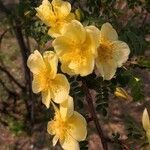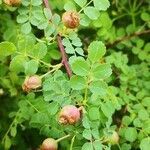Shrubs erect, 2–3 m tall. Branchlets diffuse, dense, glabrous, robust when old; prickles paired below some leaves, frequently opposite elsewhere, straight, to 1.2 cm, stout, flat, abruptly flaring to an elliptic base, small prickles and bristles absent. Leaves including petiole 3–5 cm; stipules mostly adnate to petiole, free parts linear-lanceolate, margin serrate and glandular; rachis and petiole sparsely pubescent, sometimes with small prickles; leaflets 7–13, broadly ovate or suborbicular, rarely elliptic, 6–18 × 5–10 mm, abaxially sparsely pubescent when young, glabrescent, adaxially glabrous, base broadly cuneate or subrounded, margin crenate or obtusely serrate, apex rounded-obtuse. Flower solitary, axillary, 3–4(–5) cm in diam.; pedicel 1–1.5 cm, glabrous, not glandular; bracts absent. Hypanthium subglobose or obovate, abaxially glabrous. Sepals 5, lanceolate, abaxially glabrous, adaxially sparsely pubescent, margin entire, apex acuminate. Petals 5 or double, yellow, broadly obovate, base broadly cuneate, apex emarginate. Styles free, much shorter than stamens, slightly exserted, villous. Hip purple-brown or black-brown, subglobose or obovoid, 8–10 mm in diam., glabrous, with persistent, reflexed sepals; pedicel 1–1.5 cm, glabrous. Fl. Apr–Jun, fr. Jul–Aug. 2n = 14*.
More
A shrub. It grows 1-3 m high. The small branches are hairy and brown. There are stout, straight prickles. The leaves have leaflets along the stalk. There are 7-13 leaflets and they are almost round. They are 8-20 mm long. They have teeth. The flowers occur singly and are yellow. They are 4 cm across. The fruit or hips are almost round and 1 cm across. They are red.


